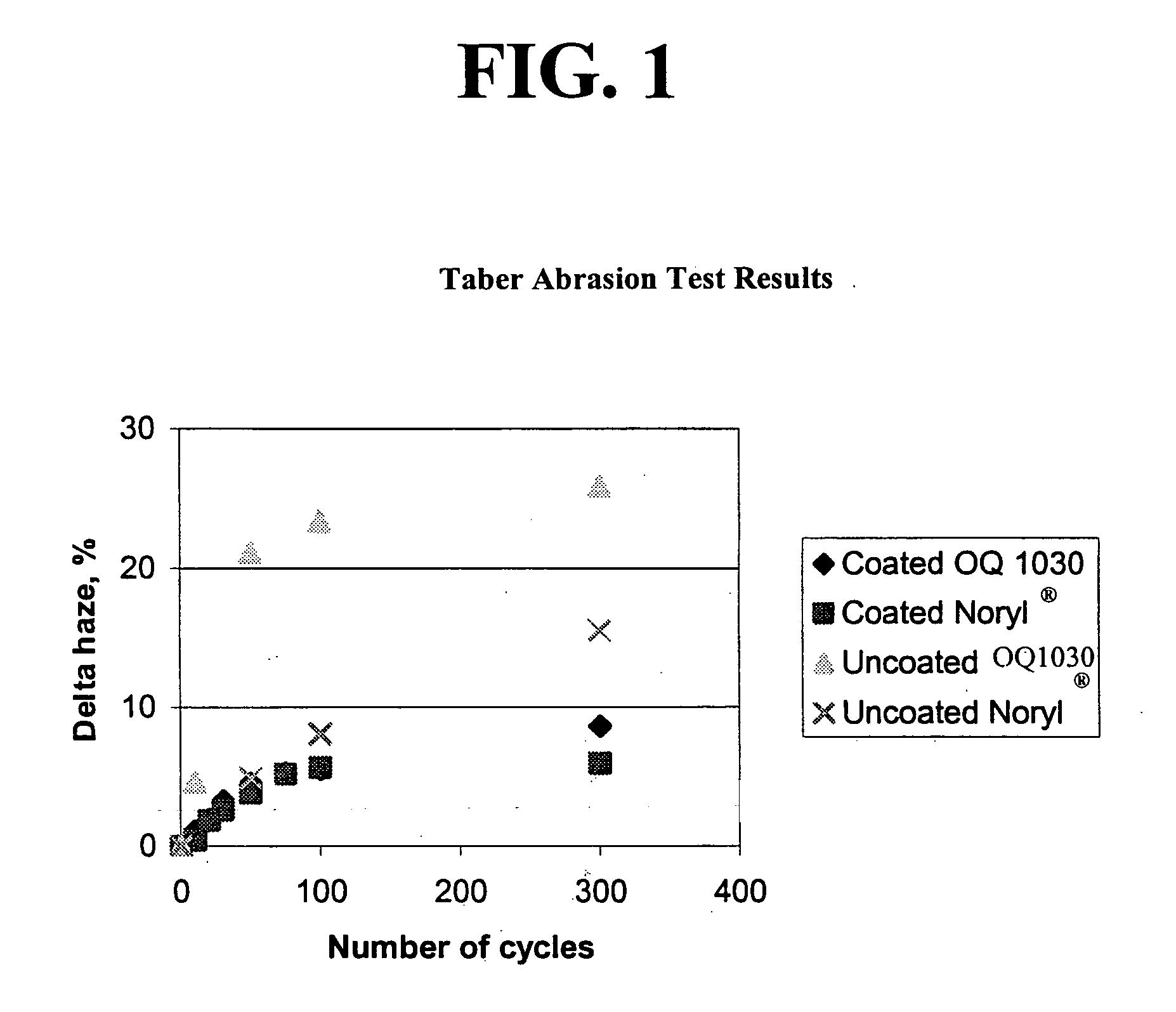Curable composition and article possessing protective layer obtained therefrom
a composition and composition technology, applied in the field of cureable compositions, can solve the problems of increasing the cost of the product, difficult to assemble in the disc manufacturing process, and not only an expensive material for pc films, so as to reduce the shrinkage of the cured composition, and be advantageous for application.
- Summary
- Abstract
- Description
- Claims
- Application Information
AI Technical Summary
Benefits of technology
Problems solved by technology
Method used
Image
Examples
example 1
[0049] To a 5 liter 3-neck flask equipped with a thermometer, a condenser, and an overhead stirrer were charged 1040 g aqueous colloidal silica (Nalco 1034A from Nalco Company) containing 34 weight percent SiO2 in water, 1460 g isopropanol, 0.816 g 4-hydroxy-2,2,6,6-tetramethyl-1-piperidinol-n-noxyl and 156 g methacryloxypropyltrimethoxysilane as functionalizing silane. The mixture was heated to 80° C. for 2 hours and then allowed to cool to 30° C. before charging 720 g methoxypropanol and, as another functionalizing silane, 380 g tricyclodecane dimethanol diacrylate (SR833S from Sartomer Company). The solvents were removed by vacuum distillation. Complete removal of solvents was accomplished by heating the batch to 60° C. for 0.5 hr under full vacuum. The resulting concentrated pre-dispersion contained about 55 weight percent functionalized nanoparticles of colloidal silica.
example 2
[0050] To a 5 liter 3-neck flask equipped with a thermometer, a condenser, and an overhead stirrer were charged 1040 g aqueous colloidal silica (Nalco 1034A from Nalco Company), containing 34 weight percent SiO2 in water, 1460 g isopropanol, 0.816 g 4-hydroxy-2,2,6,6-tetramethyl-1-piperidinol-n-noxyl and 156 g methacryloxypropyltrimethoxysilane. The mixture was heated to 80° C. for 2 hours and then allowed to cool to 30° C. before charging 720 g methoxypropanol and 291 g tricyclodecane dimethanol diacrylate (SR833S from Sartomer Company). The solvents were removed by vacuum distillation. Complete removal of solvents was accomplished by heating the batch to 60° C. for 0.5 hr under full vacuum. The resulting concentrated pre-dispersion contained about 61.5 weight percent functionalized colloidal silica nanoparticles.
example 3
[0051] A curable coating composition was prepared by mixing 150 g of the functionalized colloidal silica pre-dispersion of Example 1 with 18.92 g of 3,4-epoxycyclohexylmethyl-3,4-epoxycyclohexanecarboxylate (Cyracure™ UVR6105 from Dow Chemical), 1.21 g glycidyl methacrylate (GMA) (from Dow Chemical), 3.3 g of an acrylate polyol (Joncryl 587 from Johnson Polymer), 0.95 g of a cationic photoinitiator UVI6976 (from Dow Chemical), and 15.98 g of a free radical photoinitiator (Darocur 1173 from Ciba Specialty Chemicals). The mixture appeared optically clear and possessed a viscosity of 930 cps at 25° C. The curable composition was spincoated on a OQ1030 polycarbonate disc. The cured coating was 70 microns thick and had a Pencil Hardness of 7H. The disc was slightly negatively tilted after standing in an ambient condition overnight. The contact angle of deionized water on the cured disc was 68°.
PUM
| Property | Measurement | Unit |
|---|---|---|
| weight percent | aaaaa | aaaaa |
| particle size | aaaaa | aaaaa |
| particle size | aaaaa | aaaaa |
Abstract
Description
Claims
Application Information
 Login to View More
Login to View More - R&D
- Intellectual Property
- Life Sciences
- Materials
- Tech Scout
- Unparalleled Data Quality
- Higher Quality Content
- 60% Fewer Hallucinations
Browse by: Latest US Patents, China's latest patents, Technical Efficacy Thesaurus, Application Domain, Technology Topic, Popular Technical Reports.
© 2025 PatSnap. All rights reserved.Legal|Privacy policy|Modern Slavery Act Transparency Statement|Sitemap|About US| Contact US: help@patsnap.com

